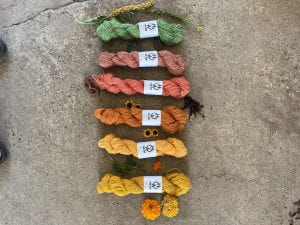Elena Schenkenberg, Senior Sociology and Environmental Studies major, shares about their internship with Old Homestead Alpacas in Walla Walla, WA
 “Hi there! I’m Elena Schenkenberg, a senior sociology-environmental studies major. I’ve been spending my summer hanging out with alpacas at Old Homestead Alpacas in Walla Walla! In this blog post, I would like to walk you through a typical day at the farm and what it takes to dye a fiber product with plants!
“Hi there! I’m Elena Schenkenberg, a senior sociology-environmental studies major. I’ve been spending my summer hanging out with alpacas at Old Homestead Alpacas in Walla Walla! In this blog post, I would like to walk you through a typical day at the farm and what it takes to dye a fiber product with plants!
When I get to the farm, I usually start with moving irrigation pipes in the pastures. It is important to do rotational grazing so that the animals have something to munch on. There are about two dozen alpacas and two Valais black nose sheep– Walter and Wyatt. After I wrangle the pipes, the rest of my day varies. Some days I’m in the garden, harvesting cut flowers for the farm’s owner and operator, Elaine Vandiver, to use in her weekly bouquets. On other days, I’m weeding or cleaning up the garden. There are days when I help Elaine with odd jobs, such as trimming the boys’ toenails or giving Walter an accidental mullet. Regardless of the other smaller tasks, it is always my job to water plants around the farm and the dye garden, along with filling the alpacas’ water buckets. If it is really hot out, they come running when they hear the hose because that means that I’ll spray their chests and they can cool off a bit. It’s just as cute as you can imagine.
Lately, I’ve been spending a lot of time in the dye house, AKA my happy place. What I do here is what I hoped to get out of this summer. I have been interested in slow fashion for a few years now, but getting my hands dirty (or indigo-stained in this case) and truly understanding how slow fashion and natural dyes work has renewed and re-sparked my interest in the subject.
Once the alpacas are sheared in the spring, the fiber is washed and processed at the mill. Some of the fiber is spun with wool to be kept as yarn. Everything else gets sent to a different mill to be woven into various types of knitwear. Elaine receives most of her processed fiber products in late summer or early fall, but we have been experimenting with some leftovers and unplanned-for lace weight yarn.
Then comes the fun part– dyeing! To dye a fiber product with plants, you first need to pretreat it in a process called mordanting. After this, the product needs to be rinsed. While that’s happening, you can start on the dye bath. It is essentially making tea with the plants. The flowers in hot water fill the dyehouse with a sweet scent, especially coreopsis. When that’s ready, you soak the garment or yarn in the hot dye bath. It then needs to be rinsed several times and air-dried.
Even writing this out, I feel like I’m not getting at just how much it takes to make naturally dyed products. I have been doing a small portion of this process. Elaine usually picks up where I leave off for the day. Even with our game of dye tag, I feel like I’m constantly rinsing and stirring and mordanting. But I love it! I honestly can’t think of a better way to spend my “last” summer. I feel connected to nature, something that I had been itching for when I was abroad last semester. When I harvest coreopsis in the dye garden with a curious alpaca sticking his head through the fence, I feel part of something. When I look at the bright yellow and green skeins of yarn, I can see how I have been a part of most of the process; watering the alpacas’ grass so they can grow their fleece, keeping their waters full, keeping them cool, watering and harvesting the dye crops, mordanting, rinsing, dyeing, rinsing again, and drying. It has been such a fulfilling experience to work alongside and learn from Elaine. It is easy to see how much love, care, and dedication she has for the farm, and it is just as easy to feel the same way when you are around her. I have truly been having the best summer ever!”
I’m glad to hear this has been such a rewarding summer for you. What a wonderful experience!